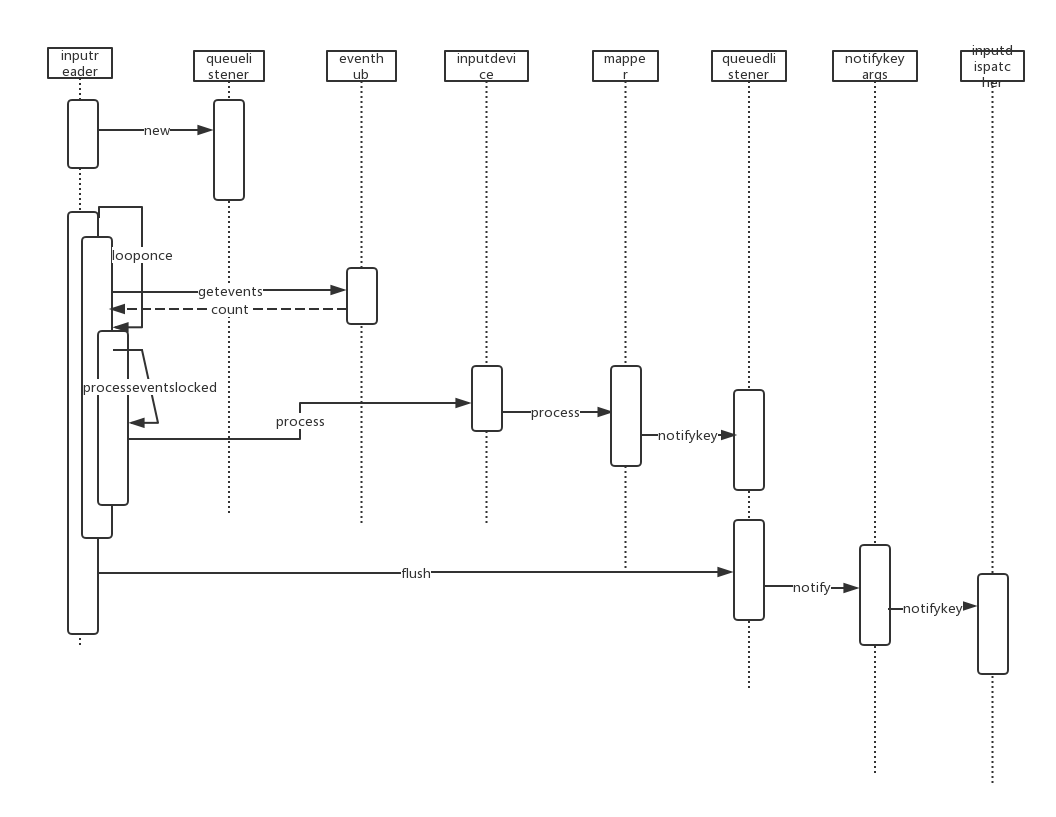inputreader对input事件的处理
上面我们可以知道读取出了事件之后,需要进行处理,那么处理的函数就是
386 if (count) {
387 processEventsLocked(mEventBuffer, count);
388 }
422void InputReader::processEventsLocked(const RawEvent* rawEvents, size_t count) {
423 for (const RawEvent* rawEvent = rawEvents; count;) {
424 int32_t type = rawEvent->type;
425 size_t batchSize = 1;
426 if (type < EventHubInterface::FIRST_SYNTHETIC_EVENT) {
427 int32_t deviceId = rawEvent->deviceId;
428 while (batchSize < count) {
429 if (rawEvent[batchSize].type >= EventHubInterface::FIRST_SYNTHETIC_EVENT
430 || rawEvent[batchSize].deviceId != deviceId) {
431 break;
432 }
433 batchSize += 1;
434 }
435#if DEBUG_RAW_EVENTS
436 ALOGD("BatchSize: %d Count: %d", batchSize, count);
437#endif
//我们其实只需要关注正常的事件而不用关注device添加和remove的事情
438 processEventsForDeviceLocked(deviceId, rawEvent, batchSize);
439 } else {
440 switch (rawEvent->type) {
441 case EventHubInterface::DEVICE_ADDED:
442 addDeviceLocked(rawEvent->when, rawEvent->deviceId);
443 break;
444 case EventHubInterface::DEVICE_REMOVED:
445 removeDeviceLocked(rawEvent->when, rawEvent->deviceId);
446 break;
447 case EventHubInterface::FINISHED_DEVICE_SCAN:
448 handleConfigurationChangedLocked(rawEvent->when);
449 break;
450 default:
451 ALOG_ASSERT(false); // can't happen
452 break;
453 }
454 }
455 count -= batchSize;
456 rawEvent += batchSize;
457 }
458}
所以可以看到,事件被分成了两种,目前我们只需要看正常的时间,而不需要关注device的添加删除等时间。
594void InputReader::processEventsForDeviceLocked(int32_t deviceId,
595 const RawEvent* rawEvents, size_t count) {
596 ssize_t deviceIndex = mDevices.indexOfKey(deviceId);//获取到对应的devices
597 if (deviceIndex < 0) {
598 ALOGW("Discarding event for unknown deviceId %d.", deviceId);
599 return;
600 }
601
602 InputDevice* device = mDevices.valueAt(deviceIndex);
603 if (device->isIgnored()) {
604 //ALOGD("Discarding event for ignored deviceId %d.", deviceId);
605 return;
606 }
607
608 device->process(rawEvents, count);//调用device的process
609}
那么调用到了process方法,process的话是由device发起的,device是在之前的device添加事件中生成的,所以可以在源码中查看相应的device是如何添加的
1174void InputDevice::process(const RawEvent* rawEvents, size_t count) {
...
1204 for (size_t i = 0; i < numMappers; i++) {
1205 InputMapper* mapper = mMappers[i];
1206 mapper->process(rawEvent);
1207 }
1208 }
1209 }
1210}
查看了之后也就会知道mapper是如何来的了,就是通过对应的device和对应的事件联系在一起,然后调用mapper的process方法,先看下mapper是如何添加的:
519InputDevice* InputReader::createDeviceLocked(int32_t deviceId, int32_t controllerNumber,
520 const InputDeviceIdentifier& identifier, uint32_t classes) {
521 InputDevice* device = new InputDevice(&mContext, deviceId, bumpGenerationLocked(),
522 controllerNumber, identifier, classes);
523
...
544 // Vibrator-like devices.
545 if (classes & INPUT_DEVICE_CLASS_VIBRATOR) {
546 device->addMapper(new VibratorInputMapper(device));
547 }
我们继续来看一下对应的process方法:
2349void KeyboardInputMapper::process(const RawEvent* rawEvent) {
2350 switch (rawEvent->type) {
...
2356 if (isKeyboardOrGamepadKey(scanCode)) {
2357 processKey(rawEvent->when, rawEvent->value != 0, scanCode, usageCode);
2358 }
...
2360 }
2411void KeyboardInputMapper::processKey(nsecs_t when, bool down, int32_t scanCode,
2412 int32_t usageCode) {
...
2492 NotifyKeyArgs args(when, getDeviceId(), mSource, policyFlags,
2493 down ? AKEY_EVENT_ACTION_DOWN : AKEY_EVENT_ACTION_UP,
2494 AKEY_EVENT_FLAG_FROM_SYSTEM, keyCode, scanCode, keyMetaState, downTime);
2495 getListener()->notifyKey(&args);
2496}
所以首先是组合成了一个notifykeyargs数据结构,同时调用了listener的notifykey方法。
155void QueuedInputListener::notifyKey(const NotifyKeyArgs* args) {
156 mArgsQueue.push(new NotifyKeyArgs(*args));
157}
也就是将事件放在了queue中而已。
这些做完以后,inputreader调用了flush方法,将事件传递给了dispatcher。
171void QueuedInputListener::flush() {
172 size_t count = mArgsQueue.size();
173 for (size_t i = 0; i < count; i++) {
174 NotifyArgs* args = mArgsQueue[i];
175 args->notify(mInnerListener);//通过notifyargs来notify
176 delete args;
177 }
178 mArgsQueue.clear();
179}
62void NotifyKeyArgs::notify(const sp<InputListenerInterface>& listener) const {
63 listener->notifyKey(this);
64}
到这里呢,整个的input事件的获取就已经完成了,下面就是input事件的分发。
UML时序图
